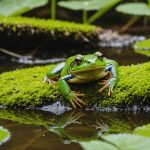Wildlife-Friendly UK Housing: Innovative Urban Planning for a Sustainable Future
As the world grapples with the challenges of climate change, biodiversity loss, and urbanization, the need for innovative and sustainable urban planning has never been more pressing. In the UK, a new wave of urban design is emerging, one that places wildlife and nature at its heart. Here, we explore the exciting initiatives and strategies that are transforming urban areas into wildlife-friendly havens, enhancing the lives of both people and the environment.
Why Urban Planning Needs to Prioritize Nature
Urban areas are often seen as the antithesis of natural habitats, but this doesn’t have to be the case. The importance of integrating nature into urban design cannot be overstated. In Cornwall, for example, the “Making Space for Nature” project has been a beacon of success in this regard. This initiative, part-funded by the European Regional Development Fund, has improved 24 spaces across Cornwall to create havens for bees, butterflies, birds, and hedgehogs[1].
Additional reading : Essential tips for uk pet owners: safeguarding wildlife during countryside adventures
“Creating new wildflower patches will contribute to the national effort to turnaround the loss of British meadows,” explains a spokesperson from Cornwall Council. “Providing pollen, nectar, and shelter for our butterflies and bees is crucial for their survival.”
Designing Cities with Biodiversity in Mind
Cities can be more than just concrete jungles; they can be vibrant ecosystems that support a wide range of wildlife. The report “Catalysing Biodiversity on Buildings” by IUCN and Holcim highlights innovative measures cities can take to integrate nature into their urban planning policies. Here are some key strategies:
Also to read : How UK Traffic Regulations Are Key to Protecting Native Wildlife from Roadkill
- Green Roofs and Walls: These can provide habitats for various species and help in reducing air pollution and improving air quality.
- Wildlife-Friendly Building Features: Incorporating features like nesting boxes and refuge for pollinators can significantly enhance urban biodiversity.
- Living Architecture: Prioritizing native species and using wildlife-friendly building approaches can make urban environments more hospitable to wildlife[3].
Practical Steps in Urban Planning
So, what does it take to make a city wildlife-friendly? Here are some practical steps that local authorities and developers can take:
Identifying and Protecting Sensitive Areas
Before any construction begins, it is crucial to survey the site to identify sensitive habitats and potential wildlife habitats. Marking off exclusion zones or rerouting construction traffic can help avoid disturbances to these areas[4].
Incorporating Green Infrastructure
Green spaces such as parks, woodlands, and verges can be transformed into wildlife havens. For instance, the “Making Space for Nature” project in Cornwall has introduced wildflower meadow patches, ponds, hedges, trees, and pollinator shrubs and perennials into various urban spaces[1].
Reducing Construction Impact
Using less invasive construction methods and machinery designed to minimize soil erosion and noise pollution can significantly reduce the impact on wildlife. Educating the public and construction teams about the importance of wildlife protection is also essential[4].
Case Studies: Success Stories in Urban Wildlife Conservation
Cornwall’s Making Space for Nature
In Cornwall, the “Making Space for Nature” project has been a resounding success. Here are some of the key areas that have been transformed:
- Beacon Park: New benches, an orchard, wildlife-friendly plants, bulbs, trees, and meadow patches have been introduced. Gardening sessions and community involvement have been integral to the project’s success[1].
- Tregoniggie Woodland: Working closely with the Friends of Tregoniggie Woodland, the project has cleared non-native trees, planted new species, and renovated grassland areas to improve floral diversity[1].
Urban Spaces in Newquay
In Newquay, the project has focused on areas like Towan Blystra Green, where community workshops were held to gather views on how to improve the space. The result was a landscape plan that included wildlife-friendly planting around the edges of the main grassed area[1].
The Role of Planning Reforms in Protecting Nature
The UK Government’s planning reforms present a significant opportunity to ensure that urban development is nature-friendly. Here are some key points from the proposed reforms:
National Planning Policy Framework
The revised National Planning Policy Framework emphasizes housing delivery but also includes measures to protect nature. For example, there is a focus on nature-friendly building features for species like Swifts and Hedgehogs[2].
Planning Reform Working Paper
The Planning Reform Working Paper proposes a strategic approach to planning, including the creation of a Nature Recovery Fund. This fund would support wider environmental improvements, such as investing in wetlands to tackle water pollution[2].
What Local Authorities and Communities Can Do
Local authorities and communities play a crucial role in making urban areas wildlife-friendly. Here are some steps they can take:
Enhancing Green Spaces
Local authorities can enhance existing green spaces by introducing wildlife-friendly plants, creating ponds, and improving access and signage. For example, in Bodmin, the “Making Space for Nature” project has introduced pollinator-friendly shrubs and perennials, along with accessible picnic benches[1].
Community Engagement
Community involvement is key to the success of such projects. Organizing gardening sessions, litter picks, and educational workshops can help build a sense of ownership and responsibility among residents.
Collaborating with Environmental Groups
Working with environmental groups and consultants can provide valuable expertise in protecting wildlife habitats. For instance, the RSPB is working closely with the UK Government to ensure that planning reforms prioritize nature recovery[2].
The Benefits of Wildlife-Friendly Urban Planning
The benefits of integrating nature into urban design are multifaceted:
Improved Health and Well-being
Green spaces and natural habitats within urban areas can significantly improve the health and well-being of residents. Studies have shown that living in areas with high levels of green space can reduce stress, improve mental health, and enhance overall quality of life.
Enhanced Biodiversity
By creating habitats for various species, urban areas can contribute to national biodiversity goals. For example, the creation of wildflower meadows can help in the recovery of pollinator populations.
Climate Change Mitigation
Urban green spaces can act as carbon sinks, helping to mitigate the effects of climate change. They also help in managing urban heat islands and reducing air pollution.
Table: Comparing Urban Planning Strategies for Wildlife Conservation
| Strategy | Description | Benefits | Examples |
|---|---|---|---|
| Green Roofs and Walls | Incorporating greenery into building design | Reduces air pollution, provides habitats | Barcelona, London[3] |
| Wildlife-Friendly Building Features | Including nesting boxes and refuges for pollinators | Enhances urban biodiversity | Berlin, Milan[3] |
| Living Architecture | Prioritizing native species and wildlife-friendly approaches | Supports local ecosystems | Paris, Zurich[3] |
| Green Infrastructure | Transforming urban spaces into wildlife havens | Improves biodiversity, enhances community health | Cornwall’s Making Space for Nature[1] |
| Community Engagement | Involving residents in gardening and conservation efforts | Builds community ownership, enhances educational outcomes | Newquay, Bodmin[1] |
| Planning Reforms | Ensuring planning policies prioritize nature recovery | Protects irreplaceable habitats, supports sustainable development | UK Government’s Planning Reform Working Paper[2] |
Quotes from Key Stakeholders
- “Creating new wildflower patches will contribute to the national effort to turnaround the loss of British meadows. Providing pollen, nectar, and shelter for our butterflies and bees is crucial for their survival.” – Cornwall Council spokesperson[1].
- “We need a nature-friendly planning system that not only protects our most valuable places for nature but also turbo-charges nature restoration and supports those who can drive positive action.” – RSPB[2].
- “The focus on the building scale is intended to highlight measures that include living architecture, prioritisation of native species, and wildlife-friendly building approaches.” – IUCN and Holcim report[3].
Innovative urban planning that prioritizes wildlife and nature is not just a moral imperative; it is a necessity for creating sustainable, healthy, and happy communities. By integrating green infrastructure, enhancing biodiversity, and engaging communities, we can transform urban areas into vibrant ecosystems that support both people and wildlife.
As we move forward, it is crucial that we continue to advocate for nature-friendly planning reforms, support local initiatives, and educate ourselves and others about the importance of protecting wildlife in urban environments. Together, we can build a future where cities are not just places to live but also thriving habitats for all forms of life.











